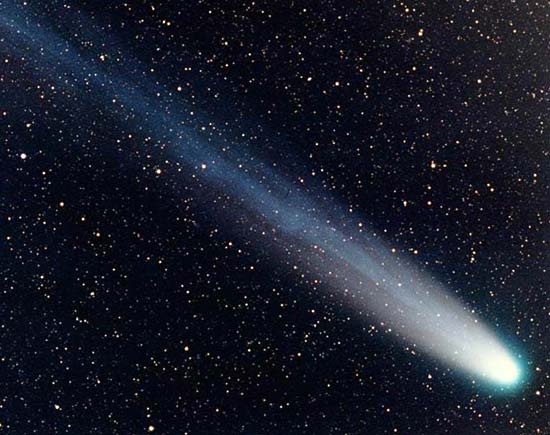Hyakutake, Comet
astronomy
 long-period comet that, because of its relatively close passage to Earth, was observed as one the brightest comets of the 20th century. It was discovered on Jan. 30, 1996, by the Japanese amateur astronomer Yuji Hyakutake using large binoculars. Visible to the naked eye in late February of that year, it became spectacular in March, developing a long blue plasma tail and a white dust tail that was much shorter but wider. It finally became five or six times as bright as a first-magnitude star when it passed Earth at a mere 0.1 astronomical unit (AU; 15 million km 【9.3 million miles】) on March 24–25. It faded away in early April and reached perihelion (closest distance to the Sun) at 0.23 AU from the Sun on May 1.
long-period comet that, because of its relatively close passage to Earth, was observed as one the brightest comets of the 20th century. It was discovered on Jan. 30, 1996, by the Japanese amateur astronomer Yuji Hyakutake using large binoculars. Visible to the naked eye in late February of that year, it became spectacular in March, developing a long blue plasma tail and a white dust tail that was much shorter but wider. It finally became five or six times as bright as a first-magnitude star when it passed Earth at a mere 0.1 astronomical unit (AU; 15 million km 【9.3 million miles】) on March 24–25. It faded away in early April and reached perihelion (closest distance to the Sun) at 0.23 AU from the Sun on May 1.- Charles A Beard
- Charles A. Dana
- Charles Addams
- Charles-Adolphe Wurtz
- Charles Albert
- Charles Albert Bender
- Charles-Albert Gobat
- Charles-Alexandre de Calonne
- Charles-Alexandre Dupuy
- Charles Alfred Pillsbury
- Charles A. Lindbergh
- Charles-Alphonse Du Fresnoy
- Charles-Amédée de Savoie, Duke de Nemours
- Charles-Amédée de Savoie Nemours, Duke de
- Charles Ancillon
- Charles; and Eames Eames, Ray
- Charles; and Eames, Ray Eames
- Charles; and Fontaine Percier, Pierre (-François-Léonard)
- Charles; and Fontaine, Pierre (-François-Léonard) Percier
- Charles-André, Count Pozzo di Borgo
- Charles-André Pozzo di Borgo, Count
- Charles-André Van Loo
- Charles Anthony Johnson
- Charles-Antoine Coypel
- Charles, Archduke